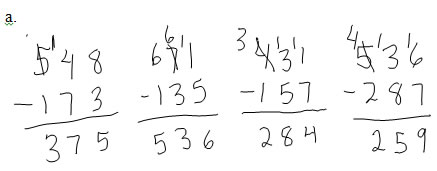

Tips and some answers (work in progress)
Questions you should know how to answer and that are reasonably likely to appear on the exam:
1. Give examples of groupable/decomposable base 10 materials, pre-grouped proportional and pregrouped non-proportional base 10 materials. Tell what the advantages are of each kind of material. (lesson 3.1)
2. Give some advantages of teaching 2-digit addition by questioning and discussing (lesson 3.3)
3. Give some advantages of teaching 2-digit addition by demonstrating and explaining (lesson 3.5)
4. Explain in words the steps in the standard algorithm (lessons 3.6 and 3.7) for
a. 263 + 182
b. 328 - 192
lesson 3.4:
5. Show how to compute 385 + 279 using:
a. the the expanded algorithm
b. the British algorithm
6. Show how to compute 48 + 24 using:
a. breaking both numbers into place value and adding within place values.
b. adding on in chunks (show with equations and number line)
c. finding friendly numbers and compensating (either version)
7. Show how to compute 623 - 184 using
a. the equal additions algorithm.
b. the expanded algorithm (breaking into place values and exchanging)
8. Explain how the trade-first algorithm is different from the standard algorithm for subtraction.
9. Show how to compute 83 - 26 using:
a. Adding up in chunks using multiples of 10 as bridge numbers (number line and equations)
b. Place value and negative numbers
c. Finding friendly numbers and compensating (any version)
10. One way of subtracting 72 - 49 is to begin by subtracting 70-40=30.
a.when you adjust this difference to account for the 2 in 72, should you add 2 or subtract 2 from 30? Explain why you add (if you add) or subtract (if you subtract).
b. when you adjust this difference to account for the 9 in 49, should you add 9 or subtract 9 from the result of part a? Explain why you add (if you add) or subtract (if you subtract).
Lesson 3.8
11. Given examples of student work, describe the process/algorithm the student is following to get their answers. Decide whether that process leads to consistently correct answers (alternate algorithm) or consistently incorrect answers (error pattern). If it is an error pattern, determine what the key understanding is that is causing problems for the student.
Examples:
12. Explain why subtracting across a 0 (as in 403-128) is difficult for children.
13. For an error pattern such as the one in problem 11, describe an intervention that you could use to reteach and correct the error.
14. Identify a multiplication or division word problem as being multiplication, partitive division or measurement division. (4.1)
15. Describe a typical way that a child would direct model to solve a multiplication problem, a measurement division problem and a partitive division problem. (4.1)
16. Write a multiplication, a measurement division and a partitive division problem. (4.1)
17. Solve a 2-step word problem, showing the solution process with bar diagrams, equations and sentences. (4.2)
18. Draw direct modeling, bar diagram and array model diagrams showing a multiplication problem. (4.3)
19. a. Explain, using an appropriate, well labelled diagram and sentences, why it works and makes sense that 4×6 = 6×4
b. What is the name of this property (spelling counts) (4.3)20. a. Explain, using an appropriate, well labelled diagram and sentences, why it makes sense that 3×8 = 3×5+3×3
b. What is the name of this property (spelling counts) (4.3)
21. Explain why the commutative property isn't obvious to a second grader (you may wish to choose a numerical example to illustrate your explanation). (4.3)
22. Know and be able to explain the double twice strategy (for 4x) (4.3)
23. Know and be able to explain the add on to a known fact (distributive law) strategy (for 3's and 6's) (4.3)
24. Know which is harder to compute: partitive or measurement division (4.4)
25. Explain what the commutative law of multiplication has to do with partitive and measurement division (4.4)
26. Solve a word problem with a remainder. Explain how the remainder affects the answer to the question. (4.4)
27. Write a division word problem for given numbers (eg. 19÷6) where the remainder is discarded and the sensible answer is the quotient. (4.4)
28. Write a division word problem for given numbers (eg. 19÷6) where the remainder is not discarded, and the sensible answer is the one more than the quotient. (4.4)